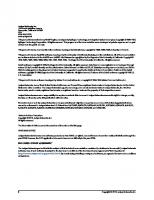Mastering Wireshark 2: Develop skills for network analysis and address a wide range of information security threats 9781788621366, 1788621360
Wireshark, a combination of Kali and Metasploit, deals with the second to the seventh layer of network protocols. The bo
337 97 55MB
English Pages 318 Year 2018
Table of contents :
Cover
Title Page
Copyright and Credits
Packt Upsell
Contributor
Table of Contents
Preface
Chapter 1: Installing Wireshark 2
Installation and setup
Installing Wireshark on Windows
Installing Wireshark on macOS
Installing Wireshark on Linux
Summary
Chapter 2: Getting Started with Wireshark
What's new in Wireshark 2?
Capturing traffic
How to capture traffic
Saving and exporting packets
Annotating and printing packets
Remote capture setup
Prerequisites
Remote capture usage
Summary
Chapter 3: Filtering Traffic
Berkeley Packet Filter (BPF) syntax
Capturing filters. Displaying filtersFollowing streams
Advanced filtering
Summary
Chapter 4: Customizing Wireshark
Preferences
Appearance
Layout
Columns
Fonts and colors
Capture
Filter buttons
Name resolution
Protocols
Statistics
Advanced
Profiles
Colorizing traffic
Examples of colorizing traffic
Example 1
Example 2
Summary
Chapter 5: Statistics
TCP/IP overview
Time values and summaries
Trace file statistics
Resolved addresses
Protocol hierarchy
Conversations
Endpoints
Packet lengths
I/O graph
Load distribution
DNS statistics
Flow graph
Expert system usage
Summary. Chapter 6: Introductory AnalysisDNS analysis
An example for DNS request failure
ARP analysis
An example for ARP request failure
IPv4 and IPv6 analysis
ICMP analysis
Using traceroute
Summary
Chapter 7: Network Protocol Analysis
UDP analysis
TCP analysis I
TCP analysis II
Graph I/O rates and TCP trends
Throughput
I/O graph
Summary
Chapter 8: Application Protocol Analysis I
DHCP analysis
HTTP analysis I
HTTP analysis II
FTP analysis
Summary
Chapter 9: Application Protocol Analysis II
Email analysis
POP and SMTP
802.11 analysis
VoIP analysis
VoIP playback
Summary. Chapter 10: Command-Line ToolsRunning Wireshark from a command line
Running tshark
Running tcpdump
Running dumpcap
Summary
Chapter 11: A Troubleshooting Scenario
Wireshark plugins
Lua programming
Determining where to capture
Capturing scenario traffic
Diagnosing scenario traffic
Summary
Other Books You May Enjoy
Index.
Cover
Title Page
Copyright and Credits
Packt Upsell
Contributor
Table of Contents
Preface
Chapter 1: Installing Wireshark 2
Installation and setup
Installing Wireshark on Windows
Installing Wireshark on macOS
Installing Wireshark on Linux
Summary
Chapter 2: Getting Started with Wireshark
What's new in Wireshark 2?
Capturing traffic
How to capture traffic
Saving and exporting packets
Annotating and printing packets
Remote capture setup
Prerequisites
Remote capture usage
Summary
Chapter 3: Filtering Traffic
Berkeley Packet Filter (BPF) syntax
Capturing filters. Displaying filtersFollowing streams
Advanced filtering
Summary
Chapter 4: Customizing Wireshark
Preferences
Appearance
Layout
Columns
Fonts and colors
Capture
Filter buttons
Name resolution
Protocols
Statistics
Advanced
Profiles
Colorizing traffic
Examples of colorizing traffic
Example 1
Example 2
Summary
Chapter 5: Statistics
TCP/IP overview
Time values and summaries
Trace file statistics
Resolved addresses
Protocol hierarchy
Conversations
Endpoints
Packet lengths
I/O graph
Load distribution
DNS statistics
Flow graph
Expert system usage
Summary. Chapter 6: Introductory AnalysisDNS analysis
An example for DNS request failure
ARP analysis
An example for ARP request failure
IPv4 and IPv6 analysis
ICMP analysis
Using traceroute
Summary
Chapter 7: Network Protocol Analysis
UDP analysis
TCP analysis I
TCP analysis II
Graph I/O rates and TCP trends
Throughput
I/O graph
Summary
Chapter 8: Application Protocol Analysis I
DHCP analysis
HTTP analysis I
HTTP analysis II
FTP analysis
Summary
Chapter 9: Application Protocol Analysis II
Email analysis
POP and SMTP
802.11 analysis
VoIP analysis
VoIP playback
Summary. Chapter 10: Command-Line ToolsRunning Wireshark from a command line
Running tshark
Running tcpdump
Running dumpcap
Summary
Chapter 11: A Troubleshooting Scenario
Wireshark plugins
Lua programming
Determining where to capture
Capturing scenario traffic
Diagnosing scenario traffic
Summary
Other Books You May Enjoy
Index.

- Author / Uploaded
- Crouthamel
- Andrew



![Network Analysis Using Wireshark 2 Cookbook: Practical recipes to analyze and secure your network using Wireshark 2 [2nd ed]
9781786461674, 1786461676](https://ebin.pub/img/200x200/network-analysis-using-wireshark-2-cookbook-practical-recipes-to-analyze-and-secure-your-network-using-wireshark-2-2nd-ed-9781786461674-1786461676.jpg)





